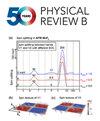电子电荷穿梭的稳健性:架构、脉冲、电荷缺陷和噪声阈值
IF 3.7
2区 物理与天体物理
Q1 Physics and Astronomy
引用次数: 0
摘要
在以半导体为基础的量子技术中,在组件之间穿梭电荷的能力是非常有用的。我们数值模拟了简单Si/SiO2器件的各种“传送带”穿梭场景,使用基于网格的分裂算子方法和随时间变化的二维势(从泊松求解器获得)明确地模拟了电子的波函数。这使我们能够充分表征电子损失概率和激发分数。值得注意的是,只有三个独立的电极,即使在存在脉冲缺陷、附近电荷缺陷和约翰逊-奈奎斯特噪声的情况下,该过程也可以保持近乎完美的绝热。只有大量的电荷缺陷,或“对抗”位置的缺陷,才能灾难性地破坏电荷穿梭。虽然我们没有明确地建立自旋自由度或谷自由度的模型,但我们从电荷传播研究中得到的结果支持这样的结论:传送带穿梭是提供半导体量子器件连接的绝佳候选者。2025年由美国物理学会出版本文章由计算机程序翻译,如有差异,请以英文原文为准。
Robustness of electron charge shuttling: Architectures, pulses, charge defects, and noise thresholds
In semiconductor-based quantum technologies, the capability to shuttle charges between components is profoundly enabling. We numerically simulated various “conveyor-belt” shuttling scenarios for simple Si/SiO2 devices, explicitly modeling the electron's wave function using grid-based split-operator methods and a time-dependent 2D potential (obtained from a Poisson solver). This allowed us to fully characterize the electron loss probability and excitation fraction. Remarkably, with as few as three independent electrodes, the process can remain near-perfectly adiabatic even in the presence of pulse imperfection, nearby charge defects, and Johnson-Nyquist noise. Only a substantial density of charge defects, or defects at “adversarial” locations, can catastrophically disrupt the charge shuttling. While we do not explicitly model the spin or valley degrees of freedom, our results from this charge propagation study support the conclusion that conveyor-belt shuttling is an excellent candidate for providing connectivity in semiconductor quantum devices. Published by the American Physical Society 2025
求助全文
通过发布文献求助,成功后即可免费获取论文全文。
去求助
来源期刊

Physical Review B
物理-物理:凝聚态物理
CiteScore
6.70
自引率
32.40%
发文量
0
审稿时长
3.0 months
期刊介绍:
Physical Review B (PRB) is the world’s largest dedicated physics journal, publishing approximately 100 new, high-quality papers each week. The most highly cited journal in condensed matter physics, PRB provides outstanding depth and breadth of coverage, combined with unrivaled context and background for ongoing research by scientists worldwide.
PRB covers the full range of condensed matter, materials physics, and related subfields, including:
-Structure and phase transitions
-Ferroelectrics and multiferroics
-Disordered systems and alloys
-Magnetism
-Superconductivity
-Electronic structure, photonics, and metamaterials
-Semiconductors and mesoscopic systems
-Surfaces, nanoscience, and two-dimensional materials
-Topological states of matter
 求助内容:
求助内容: 应助结果提醒方式:
应助结果提醒方式:


